Business Strategy Case Study: Tim Hortons Market Analysis
VerifiedAdded on 2023/05/28
|15
|2807
|270
Case Study
AI Summary
This case study analyzes Tim Hortons, examining its market position, challenges, and strategic options. The study begins with an executive summary highlighting the importance of market analysis before entering a business, followed by an introduction and background on Tim Hortons. The document delves into the problems Tim Hortons faces, including pricing and expansion challenges, and explores external factors such as market trends and competitor analysis of McDonald's and Starbucks. It also includes an internal analysis of strengths, weaknesses, resources, and core competencies. The core of the analysis focuses on strategy formulation, evaluating the current strategy and alternative strategic options like cost leadership, differentiation, and focused cost leadership. The study recommends the focused cost leadership strategy, providing reasons and outlining an implementation plan, including company-wide and functional strategies. The analysis also considers the limitations of changing strategies and concludes with a review of the case study and its implications for Tim Hortons' future.
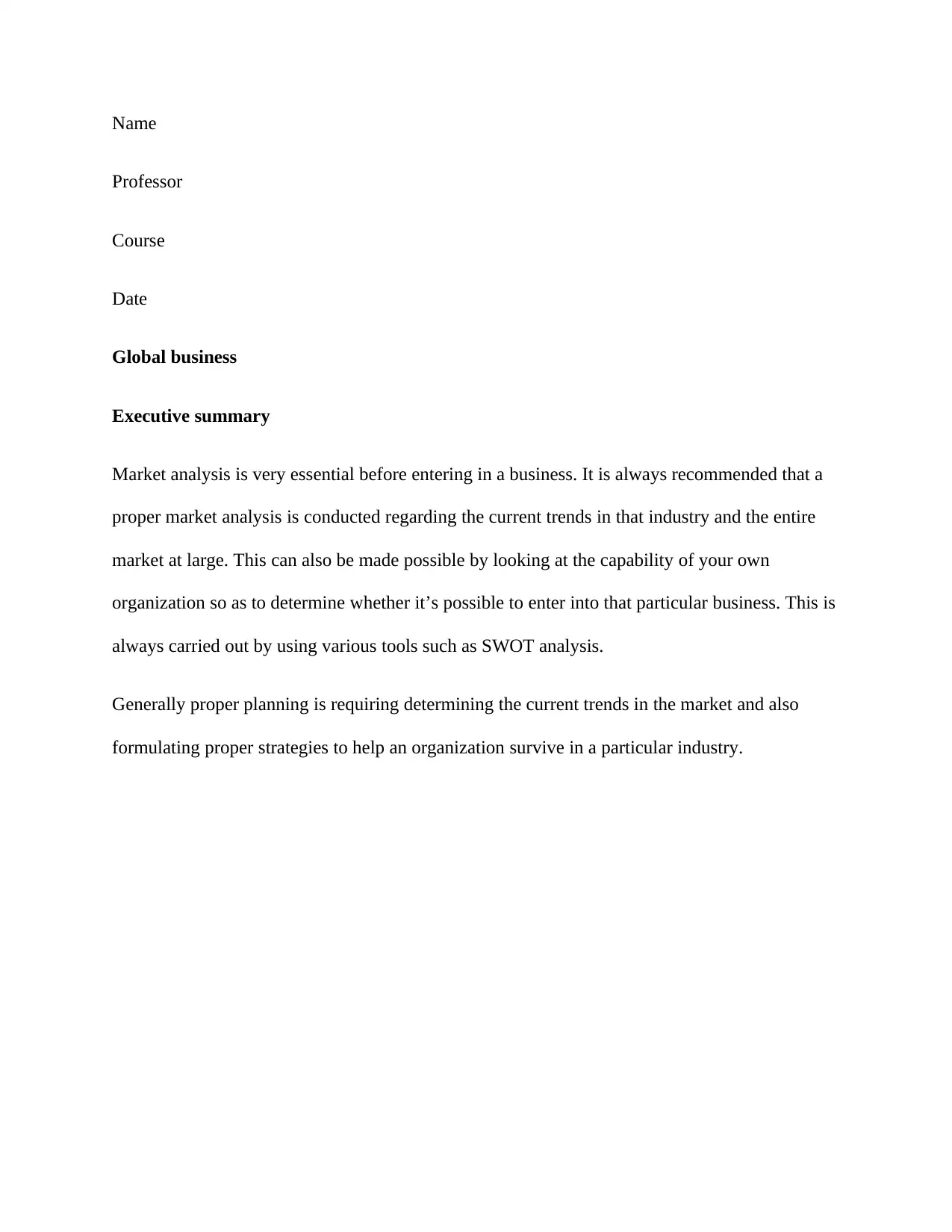
Name
Professor
Course
Date
Global business
Executive summary
Market analysis is very essential before entering in a business. It is always recommended that a
proper market analysis is conducted regarding the current trends in that industry and the entire
market at large. This can also be made possible by looking at the capability of your own
organization so as to determine whether it’s possible to enter into that particular business. This is
always carried out by using various tools such as SWOT analysis.
Generally proper planning is requiring determining the current trends in the market and also
formulating proper strategies to help an organization survive in a particular industry.
Professor
Course
Date
Global business
Executive summary
Market analysis is very essential before entering in a business. It is always recommended that a
proper market analysis is conducted regarding the current trends in that industry and the entire
market at large. This can also be made possible by looking at the capability of your own
organization so as to determine whether it’s possible to enter into that particular business. This is
always carried out by using various tools such as SWOT analysis.
Generally proper planning is requiring determining the current trends in the market and also
formulating proper strategies to help an organization survive in a particular industry.
Paraphrase This Document
Need a fresh take? Get an instant paraphrase of this document with our AI Paraphraser
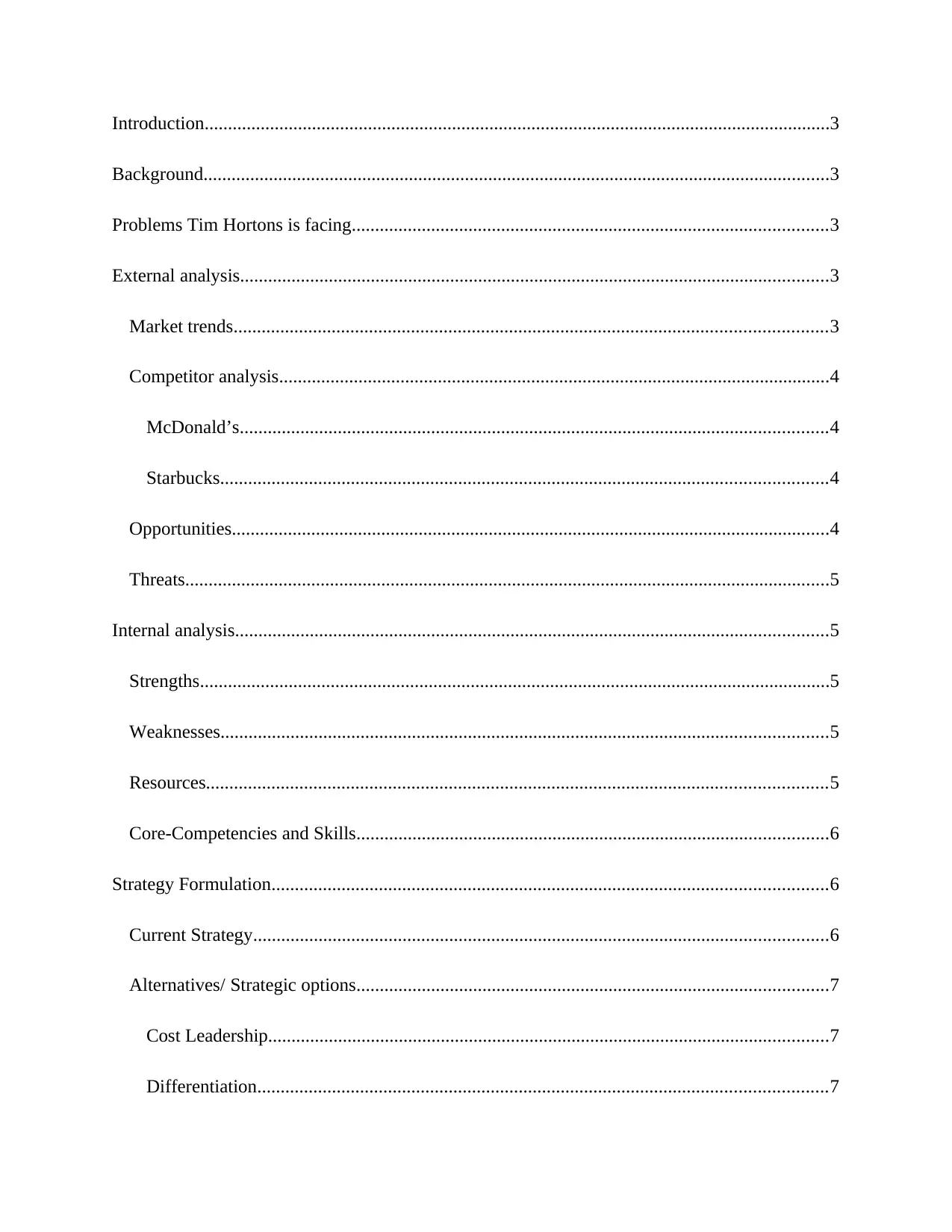
Introduction......................................................................................................................................3
Background......................................................................................................................................3
Problems Tim Hortons is facing......................................................................................................3
External analysis..............................................................................................................................3
Market trends...............................................................................................................................3
Competitor analysis......................................................................................................................4
McDonald’s..............................................................................................................................4
Starbucks..................................................................................................................................4
Opportunities................................................................................................................................4
Threats..........................................................................................................................................5
Internal analysis...............................................................................................................................5
Strengths.......................................................................................................................................5
Weaknesses..................................................................................................................................5
Resources.....................................................................................................................................5
Core-Competencies and Skills.....................................................................................................6
Strategy Formulation.......................................................................................................................6
Current Strategy...........................................................................................................................6
Alternatives/ Strategic options.....................................................................................................7
Cost Leadership........................................................................................................................7
Differentiation..........................................................................................................................7
Background......................................................................................................................................3
Problems Tim Hortons is facing......................................................................................................3
External analysis..............................................................................................................................3
Market trends...............................................................................................................................3
Competitor analysis......................................................................................................................4
McDonald’s..............................................................................................................................4
Starbucks..................................................................................................................................4
Opportunities................................................................................................................................4
Threats..........................................................................................................................................5
Internal analysis...............................................................................................................................5
Strengths.......................................................................................................................................5
Weaknesses..................................................................................................................................5
Resources.....................................................................................................................................5
Core-Competencies and Skills.....................................................................................................6
Strategy Formulation.......................................................................................................................6
Current Strategy...........................................................................................................................6
Alternatives/ Strategic options.....................................................................................................7
Cost Leadership........................................................................................................................7
Differentiation..........................................................................................................................7
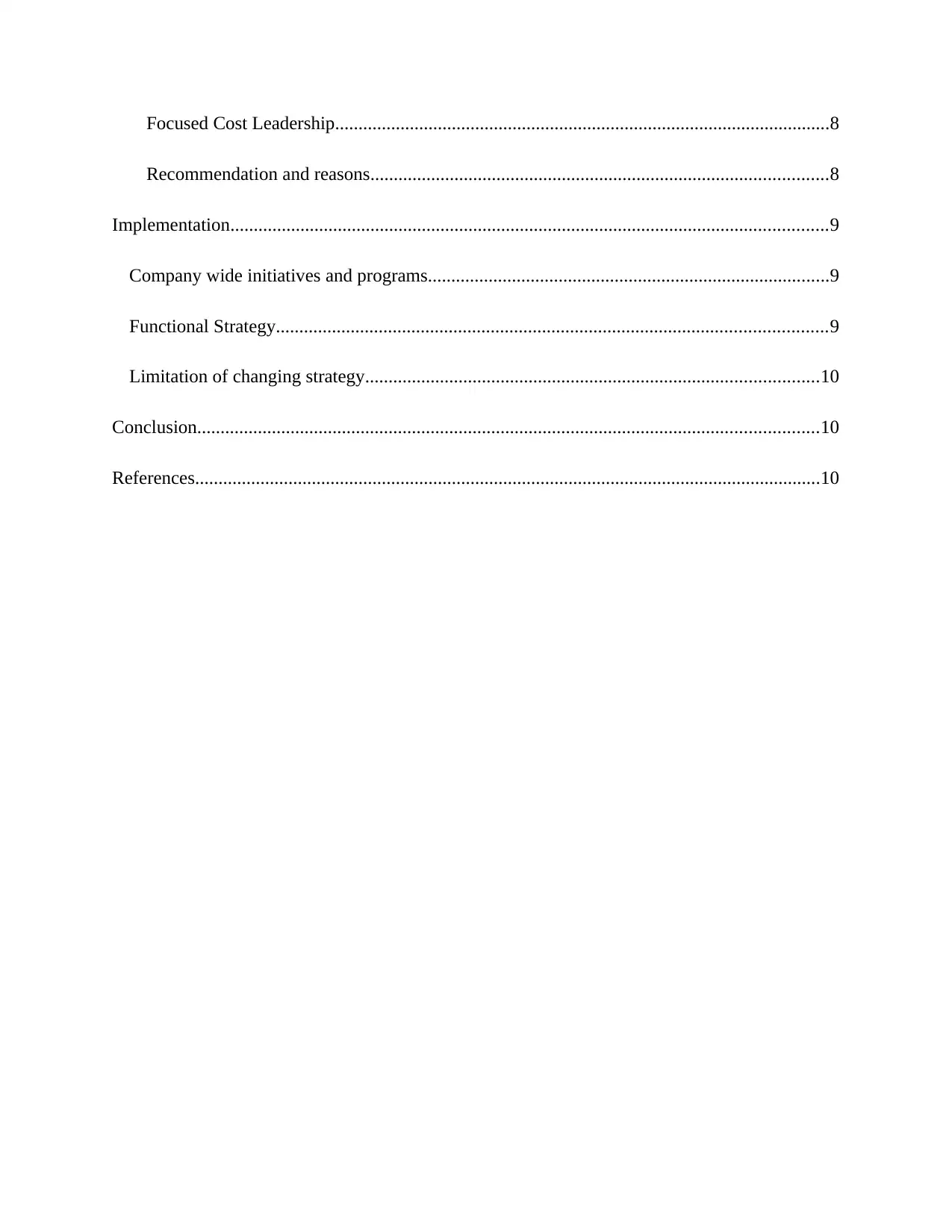
Focused Cost Leadership..........................................................................................................8
Recommendation and reasons..................................................................................................8
Implementation................................................................................................................................9
Company wide initiatives and programs......................................................................................9
Functional Strategy......................................................................................................................9
Limitation of changing strategy.................................................................................................10
Conclusion.....................................................................................................................................10
References......................................................................................................................................10
Recommendation and reasons..................................................................................................8
Implementation................................................................................................................................9
Company wide initiatives and programs......................................................................................9
Functional Strategy......................................................................................................................9
Limitation of changing strategy.................................................................................................10
Conclusion.....................................................................................................................................10
References......................................................................................................................................10
⊘ This is a preview!⊘
Do you want full access?
Subscribe today to unlock all pages.

Trusted by 1+ million students worldwide
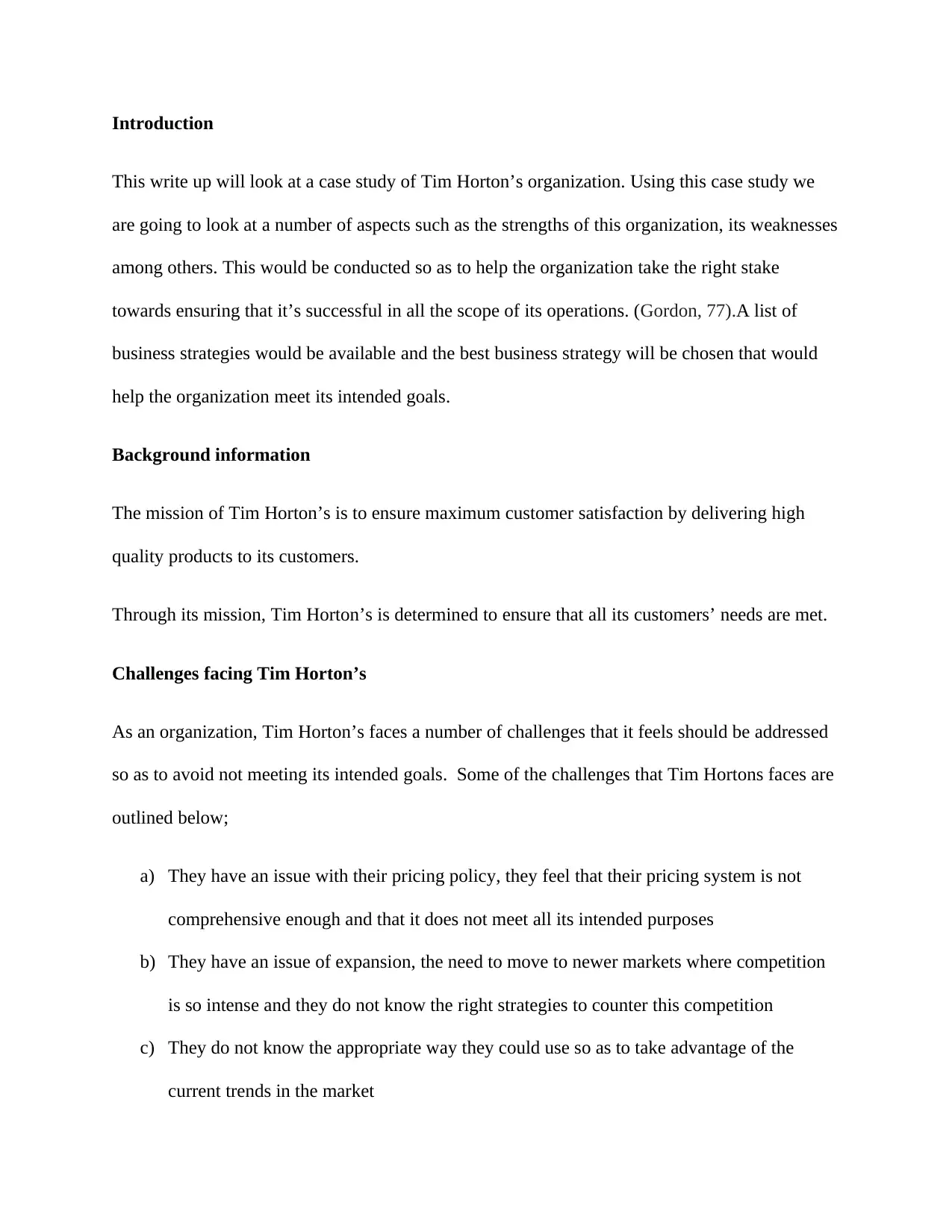
Introduction
This write up will look at a case study of Tim Horton’s organization. Using this case study we
are going to look at a number of aspects such as the strengths of this organization, its weaknesses
among others. This would be conducted so as to help the organization take the right stake
towards ensuring that it’s successful in all the scope of its operations. (Gordon, 77).A list of
business strategies would be available and the best business strategy will be chosen that would
help the organization meet its intended goals.
Background information
The mission of Tim Horton’s is to ensure maximum customer satisfaction by delivering high
quality products to its customers.
Through its mission, Tim Horton’s is determined to ensure that all its customers’ needs are met.
Challenges facing Tim Horton’s
As an organization, Tim Horton’s faces a number of challenges that it feels should be addressed
so as to avoid not meeting its intended goals. Some of the challenges that Tim Hortons faces are
outlined below;
a) They have an issue with their pricing policy, they feel that their pricing system is not
comprehensive enough and that it does not meet all its intended purposes
b) They have an issue of expansion, the need to move to newer markets where competition
is so intense and they do not know the right strategies to counter this competition
c) They do not know the appropriate way they could use so as to take advantage of the
current trends in the market
This write up will look at a case study of Tim Horton’s organization. Using this case study we
are going to look at a number of aspects such as the strengths of this organization, its weaknesses
among others. This would be conducted so as to help the organization take the right stake
towards ensuring that it’s successful in all the scope of its operations. (Gordon, 77).A list of
business strategies would be available and the best business strategy will be chosen that would
help the organization meet its intended goals.
Background information
The mission of Tim Horton’s is to ensure maximum customer satisfaction by delivering high
quality products to its customers.
Through its mission, Tim Horton’s is determined to ensure that all its customers’ needs are met.
Challenges facing Tim Horton’s
As an organization, Tim Horton’s faces a number of challenges that it feels should be addressed
so as to avoid not meeting its intended goals. Some of the challenges that Tim Hortons faces are
outlined below;
a) They have an issue with their pricing policy, they feel that their pricing system is not
comprehensive enough and that it does not meet all its intended purposes
b) They have an issue of expansion, the need to move to newer markets where competition
is so intense and they do not know the right strategies to counter this competition
c) They do not know the appropriate way they could use so as to take advantage of the
current trends in the market
Paraphrase This Document
Need a fresh take? Get an instant paraphrase of this document with our AI Paraphraser
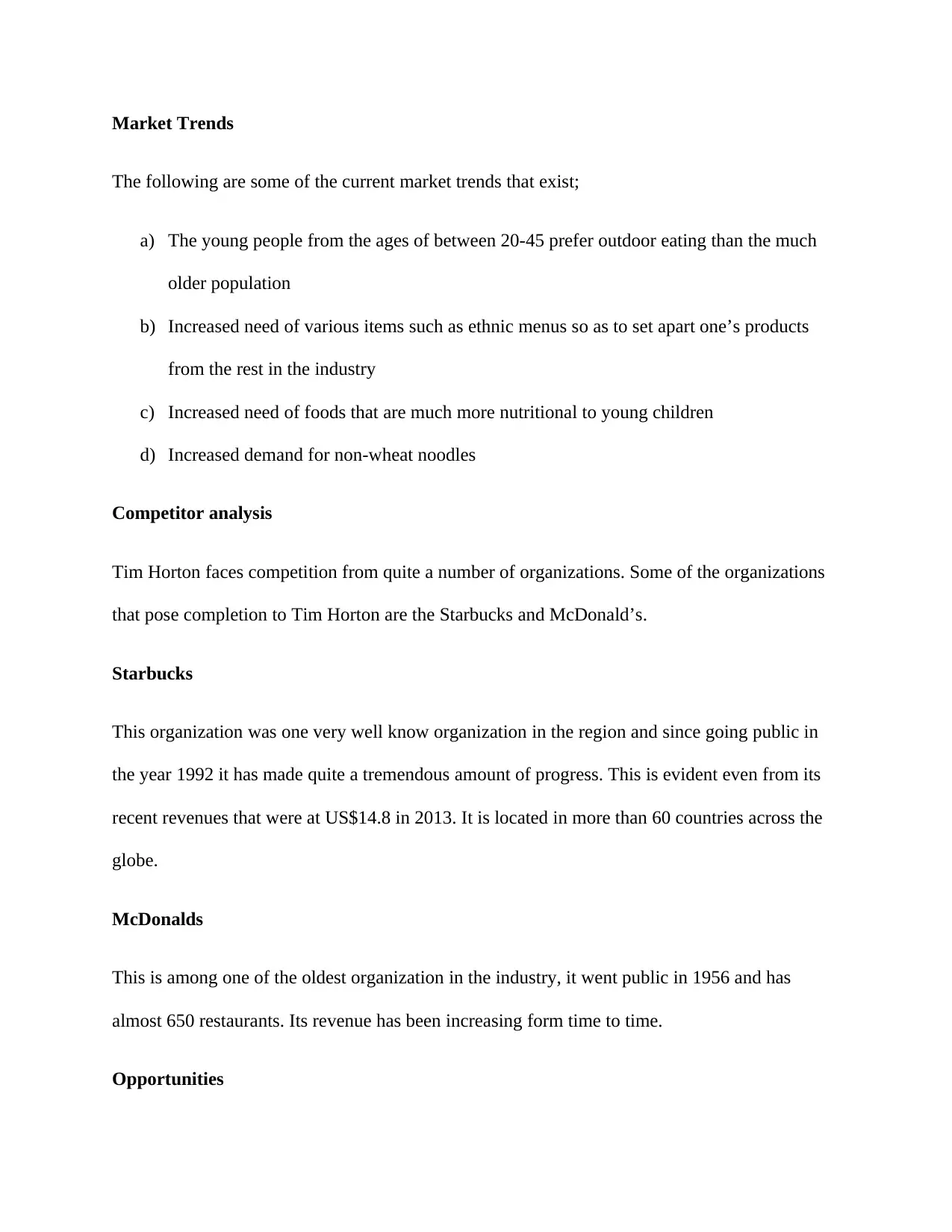
Market Trends
The following are some of the current market trends that exist;
a) The young people from the ages of between 20-45 prefer outdoor eating than the much
older population
b) Increased need of various items such as ethnic menus so as to set apart one’s products
from the rest in the industry
c) Increased need of foods that are much more nutritional to young children
d) Increased demand for non-wheat noodles
Competitor analysis
Tim Horton faces competition from quite a number of organizations. Some of the organizations
that pose completion to Tim Horton are the Starbucks and McDonald’s.
Starbucks
This organization was one very well know organization in the region and since going public in
the year 1992 it has made quite a tremendous amount of progress. This is evident even from its
recent revenues that were at US$14.8 in 2013. It is located in more than 60 countries across the
globe.
McDonalds
This is among one of the oldest organization in the industry, it went public in 1956 and has
almost 650 restaurants. Its revenue has been increasing form time to time.
Opportunities
The following are some of the current market trends that exist;
a) The young people from the ages of between 20-45 prefer outdoor eating than the much
older population
b) Increased need of various items such as ethnic menus so as to set apart one’s products
from the rest in the industry
c) Increased need of foods that are much more nutritional to young children
d) Increased demand for non-wheat noodles
Competitor analysis
Tim Horton faces competition from quite a number of organizations. Some of the organizations
that pose completion to Tim Horton are the Starbucks and McDonald’s.
Starbucks
This organization was one very well know organization in the region and since going public in
the year 1992 it has made quite a tremendous amount of progress. This is evident even from its
recent revenues that were at US$14.8 in 2013. It is located in more than 60 countries across the
globe.
McDonalds
This is among one of the oldest organization in the industry, it went public in 1956 and has
almost 650 restaurants. Its revenue has been increasing form time to time.
Opportunities
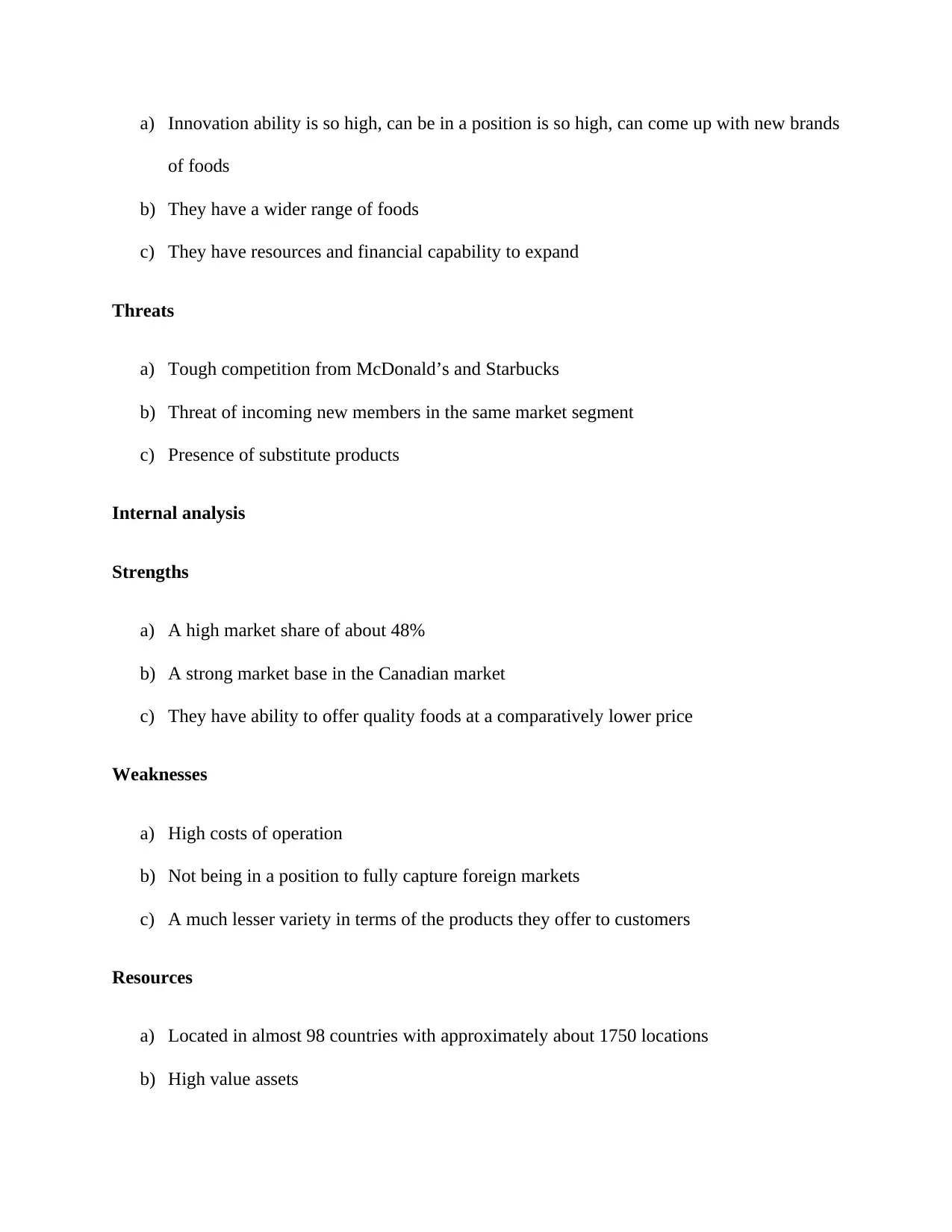
a) Innovation ability is so high, can be in a position is so high, can come up with new brands
of foods
b) They have a wider range of foods
c) They have resources and financial capability to expand
Threats
a) Tough competition from McDonald’s and Starbucks
b) Threat of incoming new members in the same market segment
c) Presence of substitute products
Internal analysis
Strengths
a) A high market share of about 48%
b) A strong market base in the Canadian market
c) They have ability to offer quality foods at a comparatively lower price
Weaknesses
a) High costs of operation
b) Not being in a position to fully capture foreign markets
c) A much lesser variety in terms of the products they offer to customers
Resources
a) Located in almost 98 countries with approximately about 1750 locations
b) High value assets
of foods
b) They have a wider range of foods
c) They have resources and financial capability to expand
Threats
a) Tough competition from McDonald’s and Starbucks
b) Threat of incoming new members in the same market segment
c) Presence of substitute products
Internal analysis
Strengths
a) A high market share of about 48%
b) A strong market base in the Canadian market
c) They have ability to offer quality foods at a comparatively lower price
Weaknesses
a) High costs of operation
b) Not being in a position to fully capture foreign markets
c) A much lesser variety in terms of the products they offer to customers
Resources
a) Located in almost 98 countries with approximately about 1750 locations
b) High value assets
⊘ This is a preview!⊘
Do you want full access?
Subscribe today to unlock all pages.

Trusted by 1+ million students worldwide
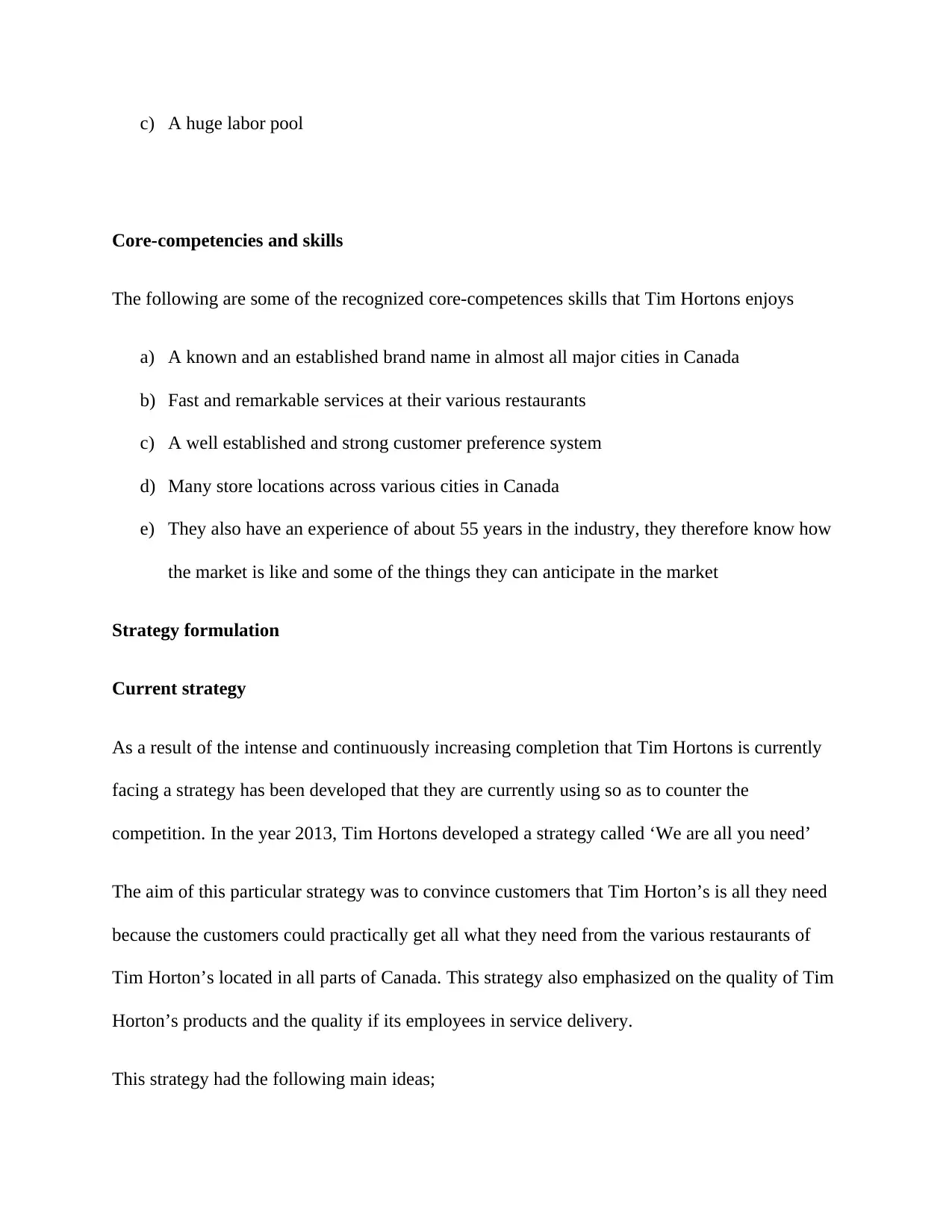
c) A huge labor pool
Core-competencies and skills
The following are some of the recognized core-competences skills that Tim Hortons enjoys
a) A known and an established brand name in almost all major cities in Canada
b) Fast and remarkable services at their various restaurants
c) A well established and strong customer preference system
d) Many store locations across various cities in Canada
e) They also have an experience of about 55 years in the industry, they therefore know how
the market is like and some of the things they can anticipate in the market
Strategy formulation
Current strategy
As a result of the intense and continuously increasing completion that Tim Hortons is currently
facing a strategy has been developed that they are currently using so as to counter the
competition. In the year 2013, Tim Hortons developed a strategy called ‘We are all you need’
The aim of this particular strategy was to convince customers that Tim Horton’s is all they need
because the customers could practically get all what they need from the various restaurants of
Tim Horton’s located in all parts of Canada. This strategy also emphasized on the quality of Tim
Horton’s products and the quality if its employees in service delivery.
This strategy had the following main ideas;
Core-competencies and skills
The following are some of the recognized core-competences skills that Tim Hortons enjoys
a) A known and an established brand name in almost all major cities in Canada
b) Fast and remarkable services at their various restaurants
c) A well established and strong customer preference system
d) Many store locations across various cities in Canada
e) They also have an experience of about 55 years in the industry, they therefore know how
the market is like and some of the things they can anticipate in the market
Strategy formulation
Current strategy
As a result of the intense and continuously increasing completion that Tim Hortons is currently
facing a strategy has been developed that they are currently using so as to counter the
competition. In the year 2013, Tim Hortons developed a strategy called ‘We are all you need’
The aim of this particular strategy was to convince customers that Tim Horton’s is all they need
because the customers could practically get all what they need from the various restaurants of
Tim Horton’s located in all parts of Canada. This strategy also emphasized on the quality of Tim
Horton’s products and the quality if its employees in service delivery.
This strategy had the following main ideas;
Paraphrase This Document
Need a fresh take? Get an instant paraphrase of this document with our AI Paraphraser
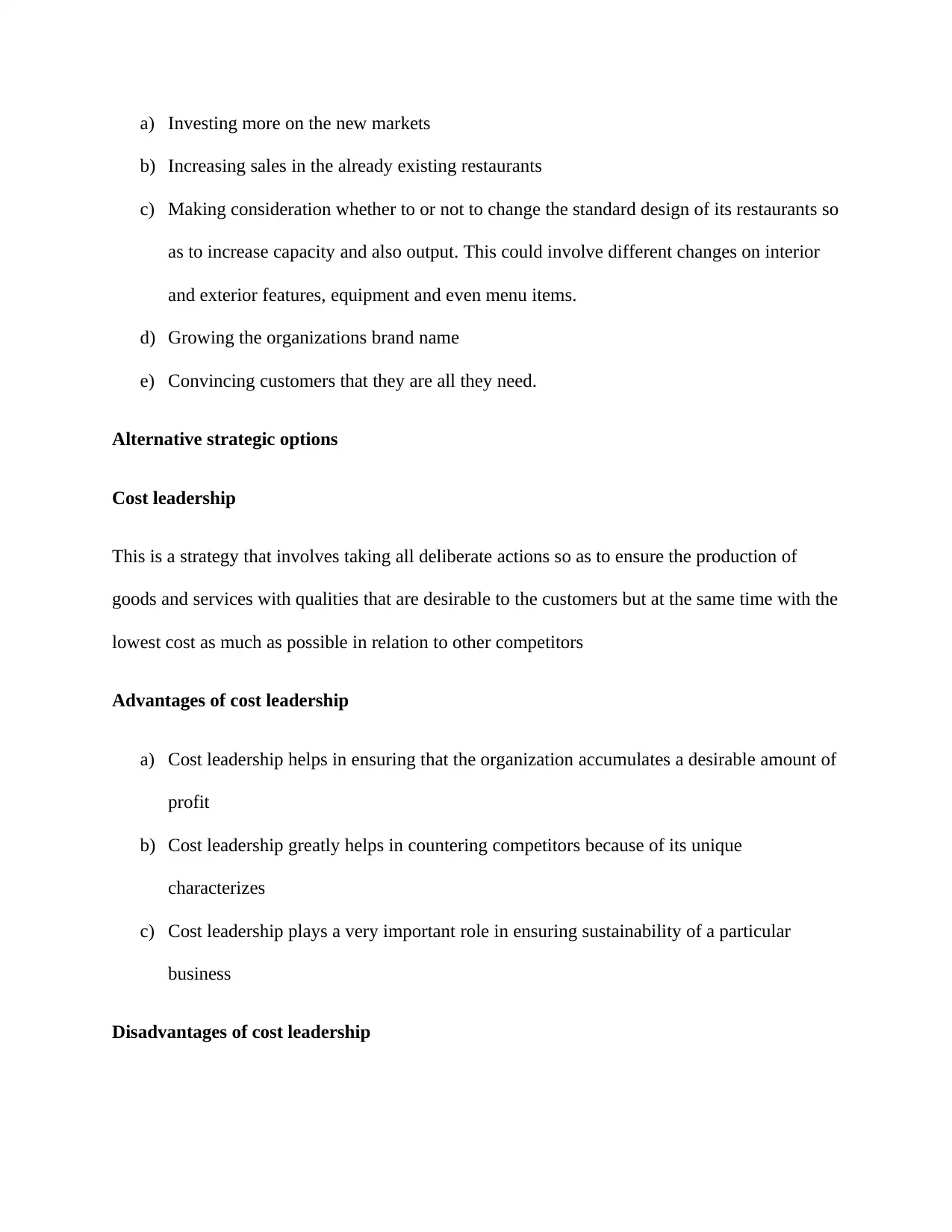
a) Investing more on the new markets
b) Increasing sales in the already existing restaurants
c) Making consideration whether to or not to change the standard design of its restaurants so
as to increase capacity and also output. This could involve different changes on interior
and exterior features, equipment and even menu items.
d) Growing the organizations brand name
e) Convincing customers that they are all they need.
Alternative strategic options
Cost leadership
This is a strategy that involves taking all deliberate actions so as to ensure the production of
goods and services with qualities that are desirable to the customers but at the same time with the
lowest cost as much as possible in relation to other competitors
Advantages of cost leadership
a) Cost leadership helps in ensuring that the organization accumulates a desirable amount of
profit
b) Cost leadership greatly helps in countering competitors because of its unique
characterizes
c) Cost leadership plays a very important role in ensuring sustainability of a particular
business
Disadvantages of cost leadership
b) Increasing sales in the already existing restaurants
c) Making consideration whether to or not to change the standard design of its restaurants so
as to increase capacity and also output. This could involve different changes on interior
and exterior features, equipment and even menu items.
d) Growing the organizations brand name
e) Convincing customers that they are all they need.
Alternative strategic options
Cost leadership
This is a strategy that involves taking all deliberate actions so as to ensure the production of
goods and services with qualities that are desirable to the customers but at the same time with the
lowest cost as much as possible in relation to other competitors
Advantages of cost leadership
a) Cost leadership helps in ensuring that the organization accumulates a desirable amount of
profit
b) Cost leadership greatly helps in countering competitors because of its unique
characterizes
c) Cost leadership plays a very important role in ensuring sustainability of a particular
business
Disadvantages of cost leadership
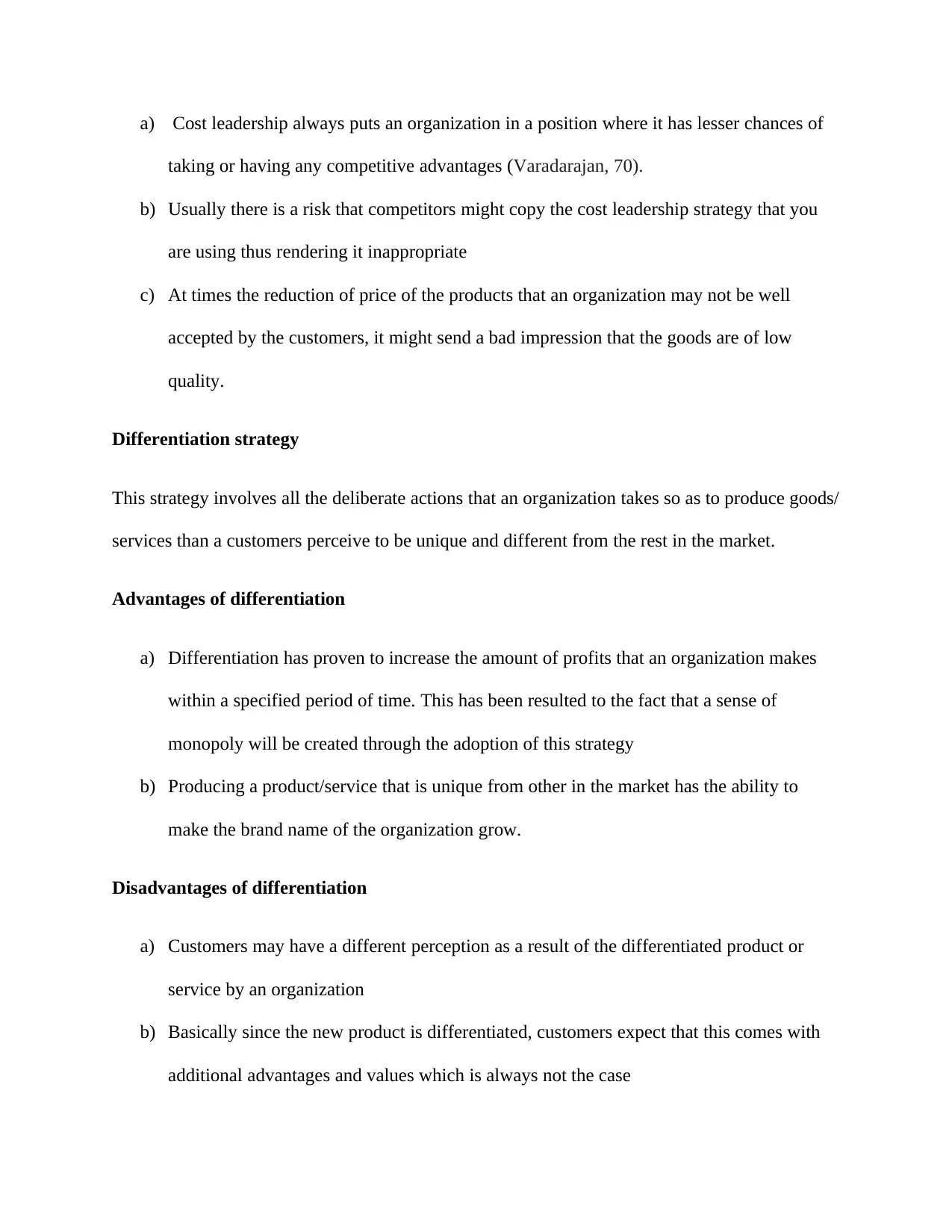
a) Cost leadership always puts an organization in a position where it has lesser chances of
taking or having any competitive advantages (Varadarajan, 70).
b) Usually there is a risk that competitors might copy the cost leadership strategy that you
are using thus rendering it inappropriate
c) At times the reduction of price of the products that an organization may not be well
accepted by the customers, it might send a bad impression that the goods are of low
quality.
Differentiation strategy
This strategy involves all the deliberate actions that an organization takes so as to produce goods/
services than a customers perceive to be unique and different from the rest in the market.
Advantages of differentiation
a) Differentiation has proven to increase the amount of profits that an organization makes
within a specified period of time. This has been resulted to the fact that a sense of
monopoly will be created through the adoption of this strategy
b) Producing a product/service that is unique from other in the market has the ability to
make the brand name of the organization grow.
Disadvantages of differentiation
a) Customers may have a different perception as a result of the differentiated product or
service by an organization
b) Basically since the new product is differentiated, customers expect that this comes with
additional advantages and values which is always not the case
taking or having any competitive advantages (Varadarajan, 70).
b) Usually there is a risk that competitors might copy the cost leadership strategy that you
are using thus rendering it inappropriate
c) At times the reduction of price of the products that an organization may not be well
accepted by the customers, it might send a bad impression that the goods are of low
quality.
Differentiation strategy
This strategy involves all the deliberate actions that an organization takes so as to produce goods/
services than a customers perceive to be unique and different from the rest in the market.
Advantages of differentiation
a) Differentiation has proven to increase the amount of profits that an organization makes
within a specified period of time. This has been resulted to the fact that a sense of
monopoly will be created through the adoption of this strategy
b) Producing a product/service that is unique from other in the market has the ability to
make the brand name of the organization grow.
Disadvantages of differentiation
a) Customers may have a different perception as a result of the differentiated product or
service by an organization
b) Basically since the new product is differentiated, customers expect that this comes with
additional advantages and values which is always not the case
⊘ This is a preview!⊘
Do you want full access?
Subscribe today to unlock all pages.

Trusted by 1+ million students worldwide
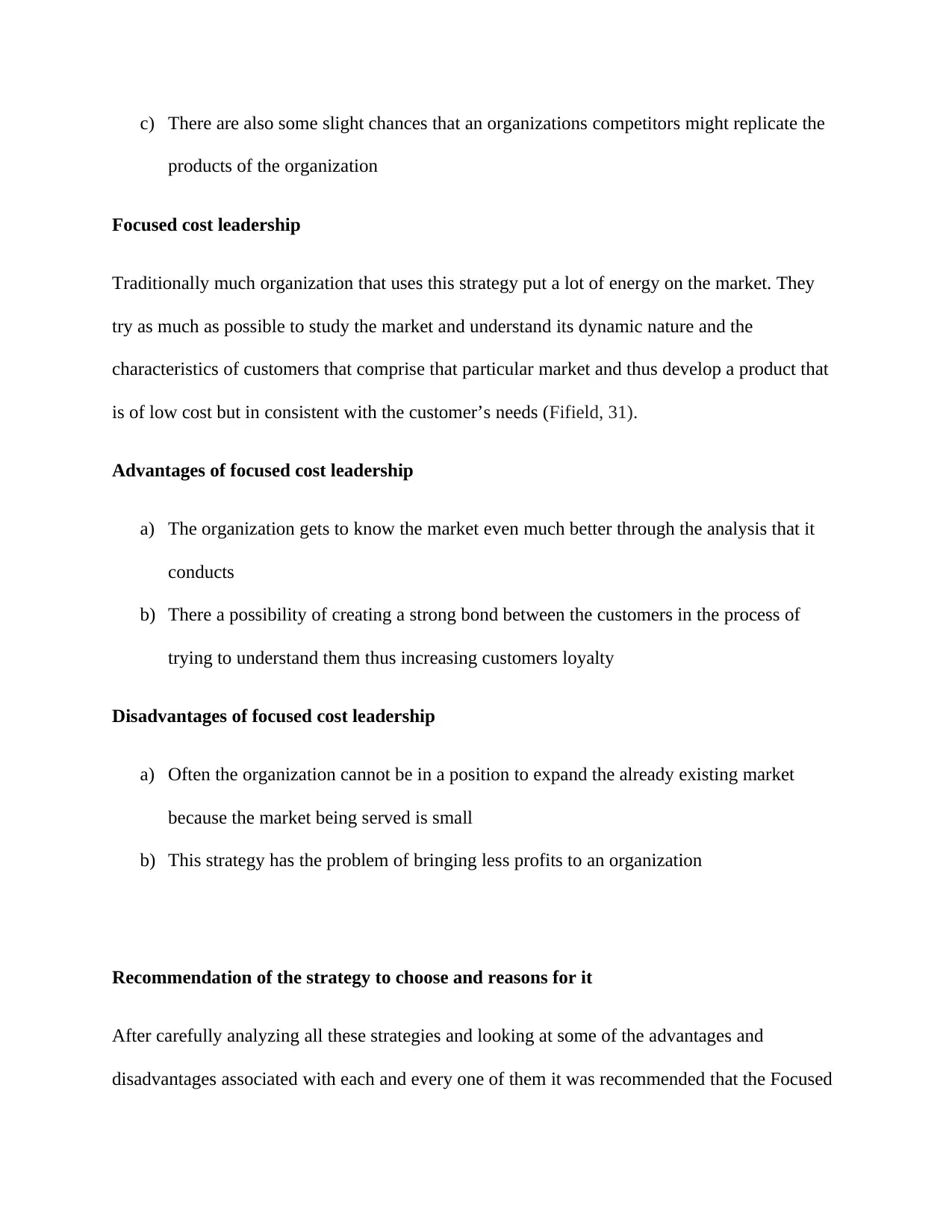
c) There are also some slight chances that an organizations competitors might replicate the
products of the organization
Focused cost leadership
Traditionally much organization that uses this strategy put a lot of energy on the market. They
try as much as possible to study the market and understand its dynamic nature and the
characteristics of customers that comprise that particular market and thus develop a product that
is of low cost but in consistent with the customer’s needs (Fifield, 31).
Advantages of focused cost leadership
a) The organization gets to know the market even much better through the analysis that it
conducts
b) There a possibility of creating a strong bond between the customers in the process of
trying to understand them thus increasing customers loyalty
Disadvantages of focused cost leadership
a) Often the organization cannot be in a position to expand the already existing market
because the market being served is small
b) This strategy has the problem of bringing less profits to an organization
Recommendation of the strategy to choose and reasons for it
After carefully analyzing all these strategies and looking at some of the advantages and
disadvantages associated with each and every one of them it was recommended that the Focused
products of the organization
Focused cost leadership
Traditionally much organization that uses this strategy put a lot of energy on the market. They
try as much as possible to study the market and understand its dynamic nature and the
characteristics of customers that comprise that particular market and thus develop a product that
is of low cost but in consistent with the customer’s needs (Fifield, 31).
Advantages of focused cost leadership
a) The organization gets to know the market even much better through the analysis that it
conducts
b) There a possibility of creating a strong bond between the customers in the process of
trying to understand them thus increasing customers loyalty
Disadvantages of focused cost leadership
a) Often the organization cannot be in a position to expand the already existing market
because the market being served is small
b) This strategy has the problem of bringing less profits to an organization
Recommendation of the strategy to choose and reasons for it
After carefully analyzing all these strategies and looking at some of the advantages and
disadvantages associated with each and every one of them it was recommended that the Focused
Paraphrase This Document
Need a fresh take? Get an instant paraphrase of this document with our AI Paraphraser
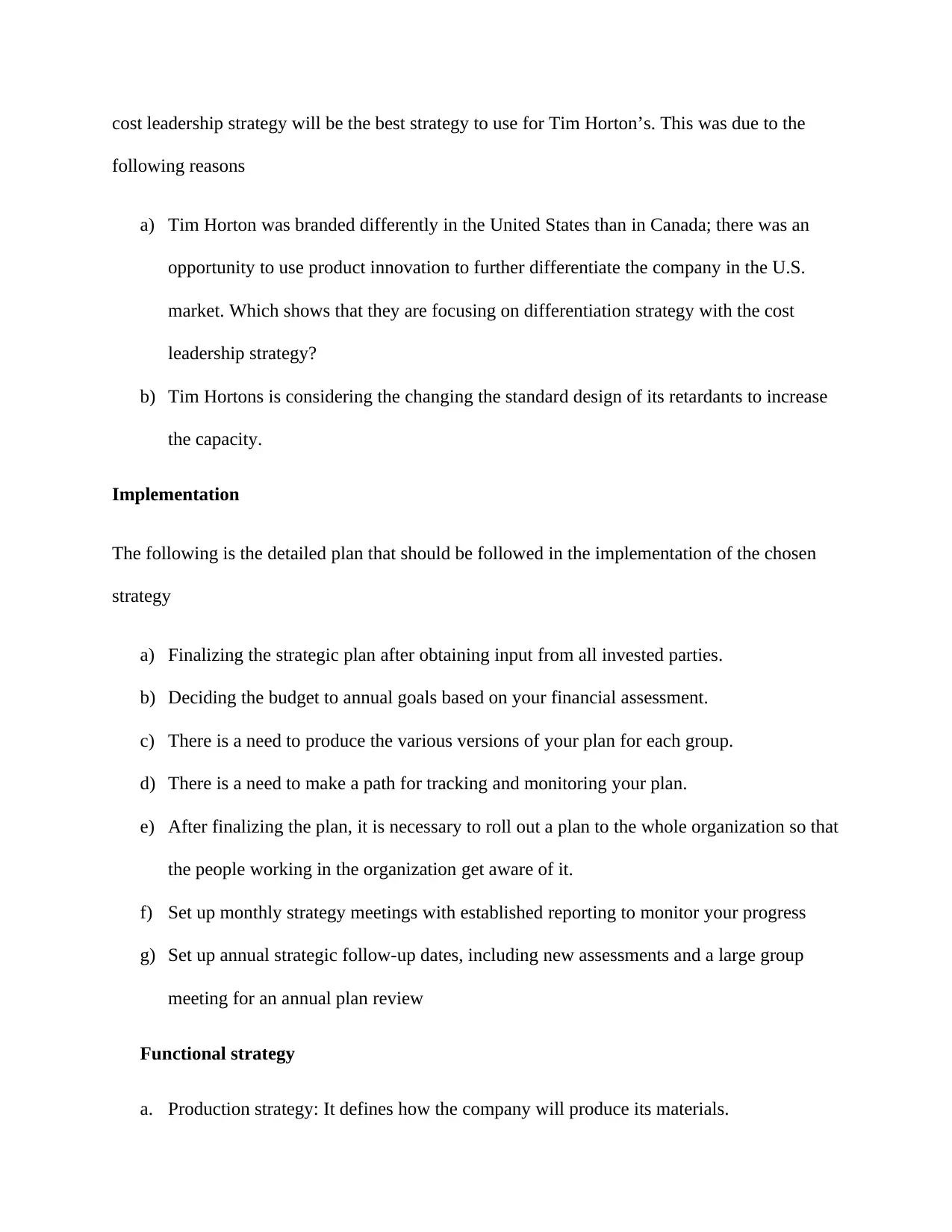
cost leadership strategy will be the best strategy to use for Tim Horton’s. This was due to the
following reasons
a) Tim Horton was branded differently in the United States than in Canada; there was an
opportunity to use product innovation to further differentiate the company in the U.S.
market. Which shows that they are focusing on differentiation strategy with the cost
leadership strategy?
b) Tim Hortons is considering the changing the standard design of its retardants to increase
the capacity.
Implementation
The following is the detailed plan that should be followed in the implementation of the chosen
strategy
a) Finalizing the strategic plan after obtaining input from all invested parties.
b) Deciding the budget to annual goals based on your financial assessment.
c) There is a need to produce the various versions of your plan for each group.
d) There is a need to make a path for tracking and monitoring your plan.
e) After finalizing the plan, it is necessary to roll out a plan to the whole organization so that
the people working in the organization get aware of it.
f) Set up monthly strategy meetings with established reporting to monitor your progress
g) Set up annual strategic follow-up dates, including new assessments and a large group
meeting for an annual plan review
Functional strategy
a. Production strategy: It defines how the company will produce its materials.
following reasons
a) Tim Horton was branded differently in the United States than in Canada; there was an
opportunity to use product innovation to further differentiate the company in the U.S.
market. Which shows that they are focusing on differentiation strategy with the cost
leadership strategy?
b) Tim Hortons is considering the changing the standard design of its retardants to increase
the capacity.
Implementation
The following is the detailed plan that should be followed in the implementation of the chosen
strategy
a) Finalizing the strategic plan after obtaining input from all invested parties.
b) Deciding the budget to annual goals based on your financial assessment.
c) There is a need to produce the various versions of your plan for each group.
d) There is a need to make a path for tracking and monitoring your plan.
e) After finalizing the plan, it is necessary to roll out a plan to the whole organization so that
the people working in the organization get aware of it.
f) Set up monthly strategy meetings with established reporting to monitor your progress
g) Set up annual strategic follow-up dates, including new assessments and a large group
meeting for an annual plan review
Functional strategy
a. Production strategy: It defines how the company will produce its materials.
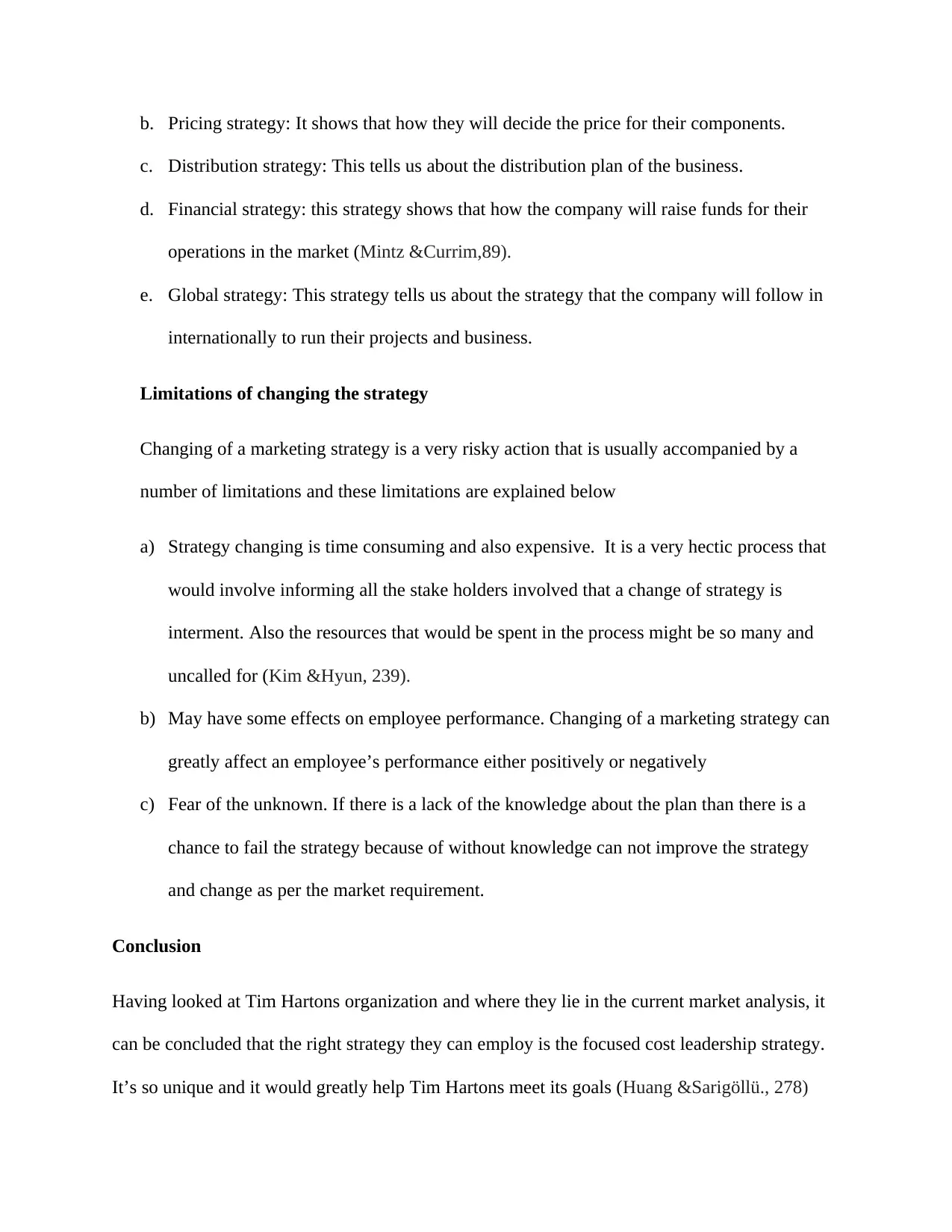
b. Pricing strategy: It shows that how they will decide the price for their components.
c. Distribution strategy: This tells us about the distribution plan of the business.
d. Financial strategy: this strategy shows that how the company will raise funds for their
operations in the market (Mintz &Currim,89).
e. Global strategy: This strategy tells us about the strategy that the company will follow in
internationally to run their projects and business.
Limitations of changing the strategy
Changing of a marketing strategy is a very risky action that is usually accompanied by a
number of limitations and these limitations are explained below
a) Strategy changing is time consuming and also expensive. It is a very hectic process that
would involve informing all the stake holders involved that a change of strategy is
interment. Also the resources that would be spent in the process might be so many and
uncalled for (Kim &Hyun, 239).
b) May have some effects on employee performance. Changing of a marketing strategy can
greatly affect an employee’s performance either positively or negatively
c) Fear of the unknown. If there is a lack of the knowledge about the plan than there is a
chance to fail the strategy because of without knowledge can not improve the strategy
and change as per the market requirement.
Conclusion
Having looked at Tim Hartons organization and where they lie in the current market analysis, it
can be concluded that the right strategy they can employ is the focused cost leadership strategy.
It’s so unique and it would greatly help Tim Hartons meet its goals (Huang &Sarigöllü., 278)
c. Distribution strategy: This tells us about the distribution plan of the business.
d. Financial strategy: this strategy shows that how the company will raise funds for their
operations in the market (Mintz &Currim,89).
e. Global strategy: This strategy tells us about the strategy that the company will follow in
internationally to run their projects and business.
Limitations of changing the strategy
Changing of a marketing strategy is a very risky action that is usually accompanied by a
number of limitations and these limitations are explained below
a) Strategy changing is time consuming and also expensive. It is a very hectic process that
would involve informing all the stake holders involved that a change of strategy is
interment. Also the resources that would be spent in the process might be so many and
uncalled for (Kim &Hyun, 239).
b) May have some effects on employee performance. Changing of a marketing strategy can
greatly affect an employee’s performance either positively or negatively
c) Fear of the unknown. If there is a lack of the knowledge about the plan than there is a
chance to fail the strategy because of without knowledge can not improve the strategy
and change as per the market requirement.
Conclusion
Having looked at Tim Hartons organization and where they lie in the current market analysis, it
can be concluded that the right strategy they can employ is the focused cost leadership strategy.
It’s so unique and it would greatly help Tim Hartons meet its goals (Huang &Sarigöllü., 278)
⊘ This is a preview!⊘
Do you want full access?
Subscribe today to unlock all pages.

Trusted by 1+ million students worldwide
1 out of 15
Related Documents
Your All-in-One AI-Powered Toolkit for Academic Success.
+13062052269
info@desklib.com
Available 24*7 on WhatsApp / Email
![[object Object]](/_next/static/media/star-bottom.7253800d.svg)
Unlock your academic potential
Copyright © 2020–2025 A2Z Services. All Rights Reserved. Developed and managed by ZUCOL.





